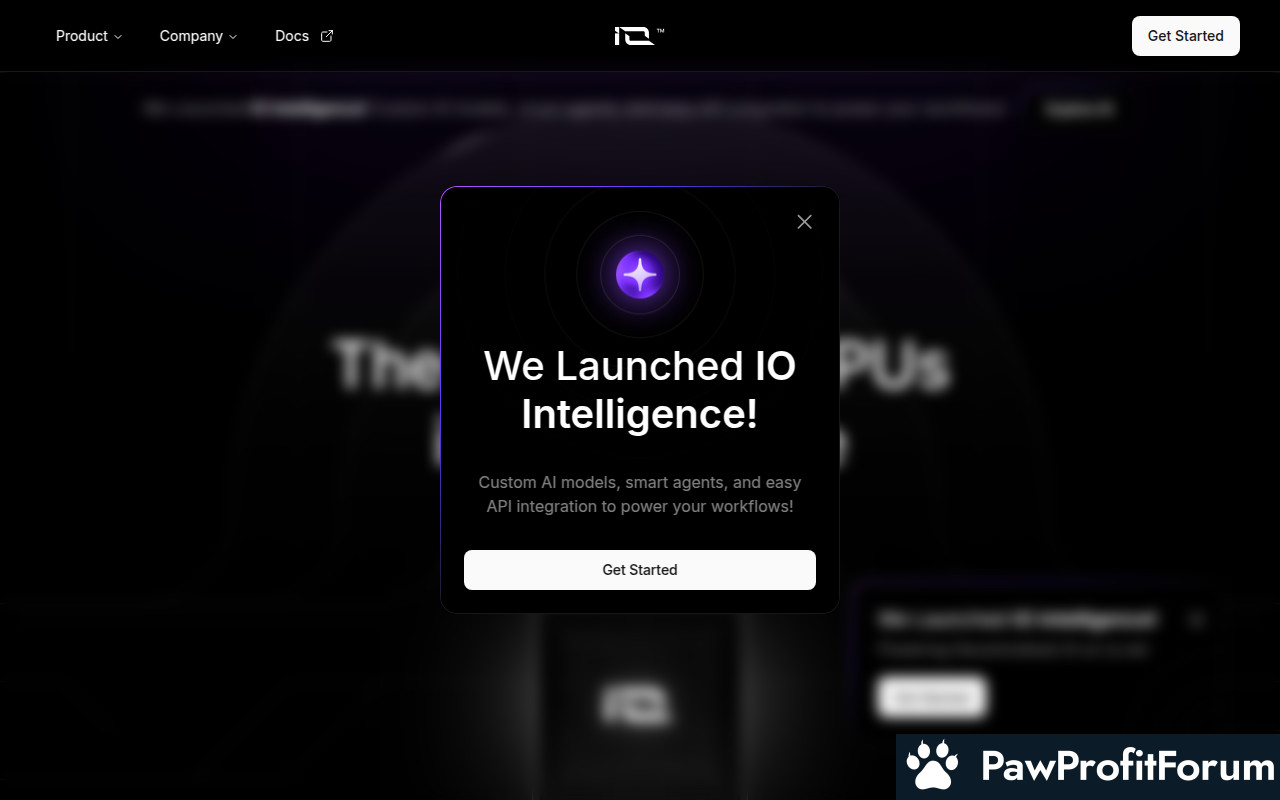io.net the world’s largest decentralized AI computing network that allows machine learning engineers to access scalable distributed clusters at a small fraction of the cost of comparable centralized services.
io.net is uniquely capable of creating clusters of tens of thousands of GPUs, whether they are co-located or geo-distributed, while maintaining low latency for deployers.
In addition to direct suppliers in the network, DePINs like Render (focused on image rendering) and Filecoin (focused on storage) also supply their compute capacity to io.net in order to access monetization from AI/ML companies.
io.net is enabling an ecosystem of products and services built on top of compute as a currency, and is bringing AI to the world by reducing costs for AI/ML innovators.
The platform serves as a central hub for tracking earnings and expenses via IO ID, and it includes a detailed insights platform akin to blockchain explorers. This makes it easier for users to manage their resources and monitor their activities within the network. io.net is owned by the organization ionet-official, which can be contacted at [email protected].
In addition to its direct suppliers, io.net integrates with DePINs like Render and Filecoin, which contribute their compute capacity to the network. This integration allows these suppliers to monetize their resources by catering to AI/ML companies. io.net thus fosters an ecosystem where compute power functions as a currency, significantly reducing costs for AI/ML innovators and enabling the development of new products and services.
The platform's ability to create clusters of tens of thousands of GPUs, while maintaining low latency, sets it apart from centralized services. This scalability and efficiency make io.net a pivotal player in bringing AI to a broader audience by lowering the barriers to entry for machine learning engineers and AI developers.
At its core, io.net leverages a blockchain to ensure the security and integrity of its operations. The blockchain records all transactions and interactions within the network, making it transparent and tamper-proof. This decentralized ledger is maintained by a network of nodes, each of which holds a copy of the blockchain. These nodes work together to validate and record new transactions, ensuring that all data is accurate and consistent across the network.
To prevent attacks from bad actors, io.net employs several security measures. One of the primary defenses is the consensus mechanism, which requires a majority of nodes to agree on the validity of a transaction before it is added to the blockchain. This makes it extremely difficult for any single entity to manipulate the data, as they would need to control a majority of the nodes. Additionally, the use of cryptographic techniques ensures that all data is securely encrypted, protecting it from unauthorized access.
io.net is uniquely capable of creating clusters of tens of thousands of GPUs, whether they are co-located or geo-distributed, while maintaining low latency for deployers. This capability allows machine learning engineers to access scalable distributed clusters at a fraction of the cost of comparable centralized services. The network's decentralized nature also means that it can tap into a wide range of GPU resources, including those from direct suppliers and other decentralized physical infrastructure networks (DePINs) like Render, which focuses on image rendering, and Filecoin, which specializes in storage. These DePINs supply their compute capacity to io.net, enabling them to monetize their resources through AI/ML companies.
The ecosystem of products and services built on top of io.net's compute-as-a-currency model is vast. By reducing costs for AI/ML innovators, io.net is democratizing access to powerful computing resources, enabling a broader range of applications and innovations in the field of artificial intelligence. This ecosystem not only supports AI and machine learning but also fosters the development of new technologies and services that can benefit from decentralized, scalable compute resources.
In addition to its technical capabilities, io.net's decentralized approach offers several advantages over traditional centralized cloud computing services. By distributing the compute resources across a wide network of nodes, io.net can provide greater resilience and redundancy, reducing the risk of downtime or service interruptions. This decentralized model also allows for more efficient use of resources, as unused compute capacity can be dynamically allocated to where it is needed most, optimizing performance and cost-efficiency.
Furthermore, io.net's integration with other DePINs like Render and Filecoin highlights its versatility and adaptability. By leveraging the strengths of these specialized networks, io.net can offer a comprehensive suite of services that cater to a wide range of computing needs, from image rendering to data storage. This collaborative approach not only enhances the overall capabilities of the network but also creates new opportunities for innovation and growth within the decentralized computing ecosystem.
One of the standout features of io.net is its ability to create clusters of tens of thousands of GPUs, whether they are co-located or geo-distributed, while maintaining low latency for deployers. This capability is crucial for applications that require significant computational power, such as large-scale data analysis, complex simulations, and real-time processing tasks.
Additionally, io.net provides decentralized GPU clusters on demand, which means users can access high-performance computing resources whenever they need them, without the need for long-term commitments or investments in expensive hardware. This flexibility is particularly useful for startups and small businesses that may not have the capital to invest in their own infrastructure.
The platform also offers a one-stop interface for CPU and GPU worker setups, simplifying the process of configuring and managing computational resources. This user-friendly approach makes it accessible to a wide range of users, from tech-savvy teenagers to older adults who may not be as familiar with the intricacies of cloud computing.
Furthermore, io.net includes IO ID, a central hub for tracking earnings and expenses, providing users with detailed insights into the network's operations. This transparency is essential for users to understand their resource usage and manage their costs effectively.
The IOG Network, a decentralized physical infrastructure network, is another critical component of io.net. It enables the integration of various decentralized physical infrastructure networks (DePINs) like Render, focused on image rendering, and Filecoin, focused on storage, to supply their compute capacity to io.net. This integration allows these networks to monetize their resources by providing compute power to AI/ML companies.
By enabling an ecosystem of products and services built on top of compute as a currency, io.net is bringing AI to the world by reducing costs for AI/ML innovators. This democratization of access to high-performance computing resources is paving the way for new advancements and innovations in the field of artificial intelligence.
The emergence of IO.NET marked a pivotal moment, establishing a foundation for decentralized AI computing. This was followed by the launch of the DePIN revolution, which stands for Decentralized Physical Infrastructure Networks. DePINs like Render, focused on image rendering, and Filecoin, focused on storage, supply their compute capacity to io.net, allowing AI/ML companies to monetize their resources effectively.
A notable development was the creation of the CloudWorkerExplorer, a tool designed to enhance the efficiency and transparency of the network. This was complemented by the introduction of IOID, a unique identifier system that streamlines user interactions within the io.net ecosystem. Additionally, the launch of IO Coin (IO) provided a native cryptocurrency to facilitate transactions and incentivize participation within the network.
io.net has also focused on community building, establishing a dedicated Discord server to foster user engagement and support. This community-driven approach has been instrumental in driving the platform's growth and adoption.
Strategic partnerships have played a crucial role in io.net's expansion. A significant collaboration with Phala Network was established, enhancing the platform's capabilities and reach. This partnership underscores io.net's commitment to integrating with other leading technologies in the blockchain space.
Changes in leadership have also been a key event, bringing in new perspectives and strategies to drive the platform forward. These leadership changes have been pivotal in navigating the rapidly evolving landscape of decentralized AI computing.
The potential for future growth remains strong, with io.net continuously exploring new opportunities and innovations. The platform's ability to reduce costs for AI/ML innovators positions it as a critical player in the ongoing development of AI technologies.
io.net's journey is marked by a series of impactful events, each contributing to its current status as a leader in decentralized AI computing. The combination of technological advancements, strategic partnerships, and community engagement has solidified its position in the blockchain and cryptocurrency ecosystem.
io.net is uniquely capable of creating clusters of tens of thousands of GPUs, whether they are co-located or geo-distributed, while maintaining low latency for deployers.
In addition to direct suppliers in the network, DePINs like Render (focused on image rendering) and Filecoin (focused on storage) also supply their compute capacity to io.net in order to access monetization from AI/ML companies.
io.net is enabling an ecosystem of products and services built on top of compute as a currency, and is bringing AI to the world by reducing costs for AI/ML innovators.
What is io.net?
io.net (IO) revolutionizes the landscape of decentralized computing by offering a robust infrastructure network that provides on-demand compute power through IO Workers. This decentralized GPU network is particularly tailored for machine learning and AI applications, delivering affordable and efficient computing resources. By leveraging the power of distributed clusters, io.net can create expansive networks of GPUs, whether co-located or geo-distributed, ensuring low latency for users.The platform serves as a central hub for tracking earnings and expenses via IO ID, and it includes a detailed insights platform akin to blockchain explorers. This makes it easier for users to manage their resources and monitor their activities within the network. io.net is owned by the organization ionet-official, which can be contacted at [email protected].
In addition to its direct suppliers, io.net integrates with DePINs like Render and Filecoin, which contribute their compute capacity to the network. This integration allows these suppliers to monetize their resources by catering to AI/ML companies. io.net thus fosters an ecosystem where compute power functions as a currency, significantly reducing costs for AI/ML innovators and enabling the development of new products and services.
The platform's ability to create clusters of tens of thousands of GPUs, while maintaining low latency, sets it apart from centralized services. This scalability and efficiency make io.net a pivotal player in bringing AI to a broader audience by lowering the barriers to entry for machine learning engineers and AI developers.
What is the technology behind io.net?
The technology behind io.net (IO) is built on the IOG Network, a decentralized physical infrastructure network that provides access to on-demand compute through independently operated hardware nodes. This decentralized GPU network offers affordable and efficient cloud computing resources for machine learning and AI applications, utilizing GPUs from various sources.At its core, io.net leverages a blockchain to ensure the security and integrity of its operations. The blockchain records all transactions and interactions within the network, making it transparent and tamper-proof. This decentralized ledger is maintained by a network of nodes, each of which holds a copy of the blockchain. These nodes work together to validate and record new transactions, ensuring that all data is accurate and consistent across the network.
To prevent attacks from bad actors, io.net employs several security measures. One of the primary defenses is the consensus mechanism, which requires a majority of nodes to agree on the validity of a transaction before it is added to the blockchain. This makes it extremely difficult for any single entity to manipulate the data, as they would need to control a majority of the nodes. Additionally, the use of cryptographic techniques ensures that all data is securely encrypted, protecting it from unauthorized access.
io.net is uniquely capable of creating clusters of tens of thousands of GPUs, whether they are co-located or geo-distributed, while maintaining low latency for deployers. This capability allows machine learning engineers to access scalable distributed clusters at a fraction of the cost of comparable centralized services. The network's decentralized nature also means that it can tap into a wide range of GPU resources, including those from direct suppliers and other decentralized physical infrastructure networks (DePINs) like Render, which focuses on image rendering, and Filecoin, which specializes in storage. These DePINs supply their compute capacity to io.net, enabling them to monetize their resources through AI/ML companies.
The ecosystem of products and services built on top of io.net's compute-as-a-currency model is vast. By reducing costs for AI/ML innovators, io.net is democratizing access to powerful computing resources, enabling a broader range of applications and innovations in the field of artificial intelligence. This ecosystem not only supports AI and machine learning but also fosters the development of new technologies and services that can benefit from decentralized, scalable compute resources.
In addition to its technical capabilities, io.net's decentralized approach offers several advantages over traditional centralized cloud computing services. By distributing the compute resources across a wide network of nodes, io.net can provide greater resilience and redundancy, reducing the risk of downtime or service interruptions. This decentralized model also allows for more efficient use of resources, as unused compute capacity can be dynamically allocated to where it is needed most, optimizing performance and cost-efficiency.
Furthermore, io.net's integration with other DePINs like Render and Filecoin highlights its versatility and adaptability. By leveraging the strengths of these specialized networks, io.net can offer a comprehensive suite of services that cater to a wide range of computing needs, from image rendering to data storage. This collaborative approach not only enhances the overall capabilities of the network but also creates new opportunities for innovation and growth within the decentralized computing ecosystem.
What are the real-world applications of io.net?
io.net (IO) is revolutionizing the way we think about cloud computing and artificial intelligence. As the world’s largest decentralized AI computing network, it offers a unique platform for machine learning engineers to access scalable distributed clusters at a fraction of the cost of traditional centralized services. This is particularly beneficial for those working on machine learning and AI applications, as it provides affordable and efficient cloud computing resources on the Solana blockchain.One of the standout features of io.net is its ability to create clusters of tens of thousands of GPUs, whether they are co-located or geo-distributed, while maintaining low latency for deployers. This capability is crucial for applications that require significant computational power, such as large-scale data analysis, complex simulations, and real-time processing tasks.
Additionally, io.net provides decentralized GPU clusters on demand, which means users can access high-performance computing resources whenever they need them, without the need for long-term commitments or investments in expensive hardware. This flexibility is particularly useful for startups and small businesses that may not have the capital to invest in their own infrastructure.
The platform also offers a one-stop interface for CPU and GPU worker setups, simplifying the process of configuring and managing computational resources. This user-friendly approach makes it accessible to a wide range of users, from tech-savvy teenagers to older adults who may not be as familiar with the intricacies of cloud computing.
Furthermore, io.net includes IO ID, a central hub for tracking earnings and expenses, providing users with detailed insights into the network's operations. This transparency is essential for users to understand their resource usage and manage their costs effectively.
The IOG Network, a decentralized physical infrastructure network, is another critical component of io.net. It enables the integration of various decentralized physical infrastructure networks (DePINs) like Render, focused on image rendering, and Filecoin, focused on storage, to supply their compute capacity to io.net. This integration allows these networks to monetize their resources by providing compute power to AI/ML companies.
By enabling an ecosystem of products and services built on top of compute as a currency, io.net is bringing AI to the world by reducing costs for AI/ML innovators. This democratization of access to high-performance computing resources is paving the way for new advancements and innovations in the field of artificial intelligence.
What key events have there been for io.net?
io.net, the world’s largest decentralized AI computing network, has made significant strides in the blockchain and cryptocurrency space. This platform enables machine learning engineers to access scalable distributed clusters at a fraction of the cost of centralized services. Its ability to create clusters of tens of thousands of GPUs, whether co-located or geo-distributed, while maintaining low latency, sets it apart in the industry.The emergence of IO.NET marked a pivotal moment, establishing a foundation for decentralized AI computing. This was followed by the launch of the DePIN revolution, which stands for Decentralized Physical Infrastructure Networks. DePINs like Render, focused on image rendering, and Filecoin, focused on storage, supply their compute capacity to io.net, allowing AI/ML companies to monetize their resources effectively.
A notable development was the creation of the CloudWorkerExplorer, a tool designed to enhance the efficiency and transparency of the network. This was complemented by the introduction of IOID, a unique identifier system that streamlines user interactions within the io.net ecosystem. Additionally, the launch of IO Coin (IO) provided a native cryptocurrency to facilitate transactions and incentivize participation within the network.
io.net has also focused on community building, establishing a dedicated Discord server to foster user engagement and support. This community-driven approach has been instrumental in driving the platform's growth and adoption.
Strategic partnerships have played a crucial role in io.net's expansion. A significant collaboration with Phala Network was established, enhancing the platform's capabilities and reach. This partnership underscores io.net's commitment to integrating with other leading technologies in the blockchain space.
Changes in leadership have also been a key event, bringing in new perspectives and strategies to drive the platform forward. These leadership changes have been pivotal in navigating the rapidly evolving landscape of decentralized AI computing.
The potential for future growth remains strong, with io.net continuously exploring new opportunities and innovations. The platform's ability to reduce costs for AI/ML innovators positions it as a critical player in the ongoing development of AI technologies.
io.net's journey is marked by a series of impactful events, each contributing to its current status as a leader in decentralized AI computing. The combination of technological advancements, strategic partnerships, and community engagement has solidified its position in the blockchain and cryptocurrency ecosystem.
Who are the founders of io.net?
io.net, the world’s largest decentralized AI computing network, was founded by a diverse team of visionaries. Ahmad Shadid, Tory Green, Basem Oubah, and Matej Tomazin played pivotal roles in its inception. Tory Green, who is also the current CEO, has been instrumental in steering the project. The founders' backgrounds span various fields, contributing to the robust foundation of io.net (IO). Their collective expertise has enabled the creation of a network capable of forming clusters of tens of thousands of GPUs, maintaining low latency, and significantly reducing costs for AI/ML innovators.| Website | io.net/ |
| Website | docs.io.net |
| Socials | twitter.com/ionet |
| Socials | github.com/ionet-official |
| Socials | discord.gg/ionetofficial |
| Contracts | BZLbGT...wr646K |
| Explorers | solscan.io/token/BZLbGTNCSFfoth2GYDtwr7e4imWzpR5jqcUuGEwr646K |
| Wallets | www.binance.com/en/web3wallet |
| Wallets | www.trustwallet.com/ |
| Wallets | solflare.com/ |
| Wallets | backpack.app/downloads |










